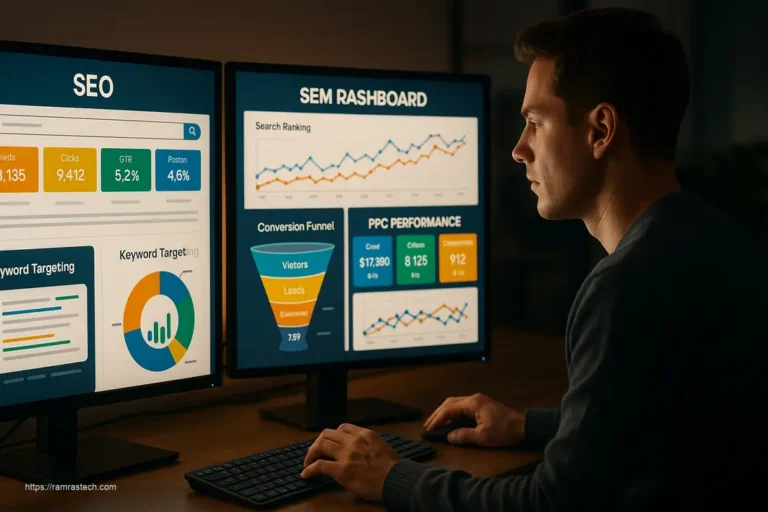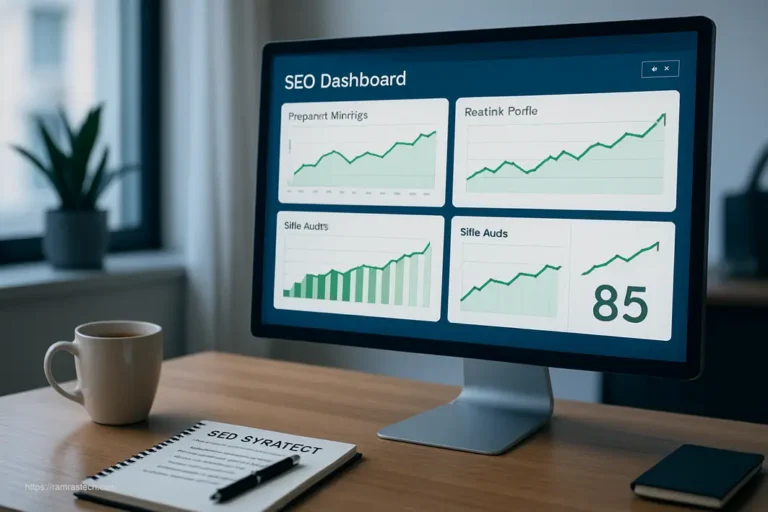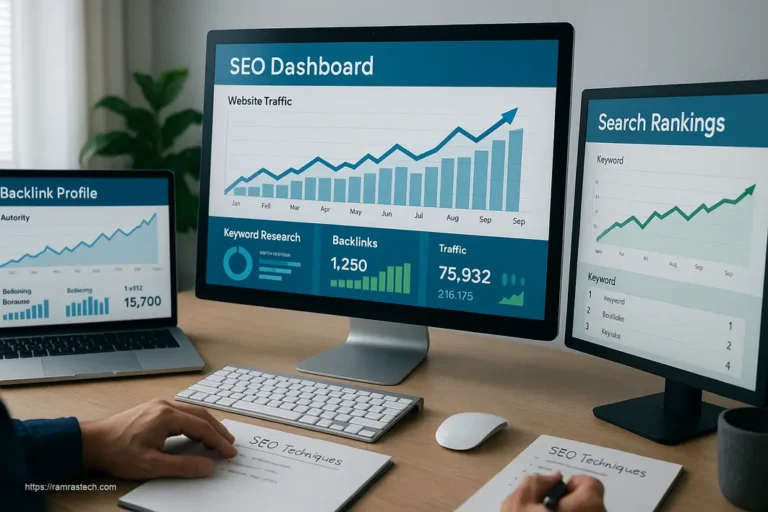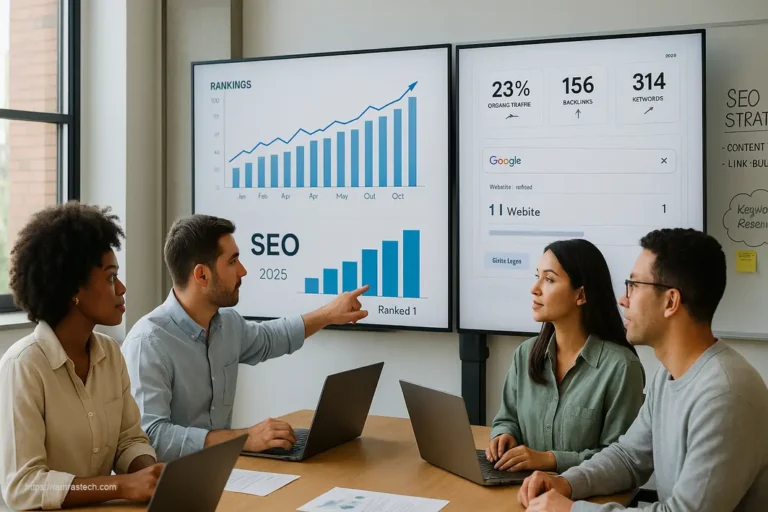Maximizing Search Engine Rankings: A Guide to SEO-Friendly Web Design Services

Understanding SEO-Friendly Web Design: The Basics
In today’s digital landscape, having a well-designed website is no longer enough to guarantee online success. To truly stand out and attract organic traffic, your website needs to be optimized for search engines. This is where SEO-friendly web design services come into play.
SEO-friendly web design is the practice of creating websites that are not only visually appealing and user-friendly but also structured and coded in a way that makes them easily discoverable and rankable by search engines. It involves a combination of technical, on-page, and content-related elements that work together to improve your site’s visibility in search engine results pages (SERPs).
By implementing SEO-friendly design principles, you can ensure that your website is both attractive to users and easily crawlable by search engine bots. This dual approach helps you achieve higher rankings, increased organic traffic, and ultimately, better conversion rates.
Why SEO and Web Design Go Hand in Hand
Gone are the days when SEO and web design were considered separate disciplines. In today’s competitive online environment, these two aspects of digital marketing are inextricably linked. Here’s why:
- User Experience: Search engines like Google prioritize websites that provide a positive user experience. A well-designed, easy-to-navigate website is more likely to keep visitors engaged, reducing bounce rates and increasing time on site – both of which are important ranking factors.
- Mobile-First Indexing: With the majority of internet users accessing websites via mobile devices, search engines now use mobile-first indexing. This means that the mobile version of your website is considered the primary version for ranking purposes. A responsive, mobile-friendly design is therefore crucial for SEO success.
- Page Speed: Website loading speed is a critical ranking factor. A well-optimized website design can significantly improve load times, leading to better user experience and higher search engine rankings.
- Content Structure: Proper content organization and information architecture not only make your website more user-friendly but also help search engines understand and index your content more effectively.
- Technical SEO: Many technical SEO elements, such as proper URL structure, XML sitemaps, and schema markup, are directly related to how your website is designed and built.
By integrating SEO best practices into your web design process, you can create a website that not only looks great but also performs well in search engine rankings.
Key Elements of SEO-Friendly Web Design Services
When seeking SEO-friendly web design services, it’s important to understand the key elements that contribute to a search engine optimized website. Here are some crucial components to look for:
- Clean, Semantic Code: A well-structured, clean code base is essential for search engines to crawl and understand your website. Look for services that prioritize semantic HTML5 markup and follow web standards.
- Responsive Design: Ensure that the design service offers mobile-responsive layouts that adapt seamlessly to different screen sizes and devices.
- Fast Loading Times: Opt for services that emphasize performance optimization, including image compression, minification of CSS and JavaScript, and leveraging browser caching.
- Intuitive Navigation: A logical site structure with clear, descriptive menus helps both users and search engines navigate your content effectively.
- SEO-Friendly URL Structure: Choose services that implement clean, keyword-rich URLs that accurately describe the content of each page.
- Content Management System (CMS) Integration: A user-friendly CMS allows you to easily update and optimize your content, which is crucial for ongoing SEO efforts.
- Schema Markup Implementation: Look for services that can implement structured data markup to help search engines better understand your content.
- XML Sitemap Generation: Ensure that the service includes the creation and submission of XML sitemaps to search engines.
- Integration with Analytics Tools: Choose a service that can seamlessly integrate your website with analytics platforms like Google Analytics for tracking and improving performance.
By prioritizing these elements in your web design process, you’ll be laying a solid foundation for long-term SEO success.
The Impact of Website Structure on Search Engine Rankings
The structure of your website plays a crucial role in how search engines crawl, understand, and rank your content. A well-organized site structure not only improves user experience but also helps search engines efficiently index your pages.
Here are some key aspects of website structure that impact SEO:
- Hierarchy: Organize your content in a logical hierarchy, with your most important pages closer to the homepage. This helps distribute link equity effectively and signals the relative importance of different pages to search engines.
- Internal Linking: Implement a strategic internal linking structure that connects related content and helps both users and search engines navigate your site. Use descriptive anchor text for internal links to provide context about the linked page.
- URL Structure: Create clean, descriptive URLs that reflect your site’s hierarchy. For example, “yourwebsite.com/category/subcategory/page-name” is more SEO-friendly than a URL with random numbers or characters.
- Breadcrumbs: Implement breadcrumb navigation to show users (and search engines) the path from the homepage to their current location on your site. This improves navigation and helps search engines understand your site structure.
- Header Tags: Use header tags (H1, H2, H3, etc.) to create a clear content hierarchy on each page. This helps both users and search engines understand the structure and importance of different sections of content.
By focusing on these structural elements, you can create a website that is not only user-friendly but also optimized for search engine crawling and indexing.
Mobile Responsiveness: A Crucial Factor for SEO Success
In today’s mobile-first world, having a responsive website design is no longer optional – it’s essential for SEO success. Here’s why mobile responsiveness is so crucial and how it impacts your search engine rankings:
- Mobile-First Indexing: Google now uses the mobile version of your website for indexing and ranking. If your site isn’t mobile-friendly, it may struggle to rank well in search results, even for desktop searches.
- User Experience: Mobile-responsive designs provide a better user experience across all devices. This leads to lower bounce rates and higher engagement metrics, which are important ranking factors.
- Page Speed: Responsive designs often load faster on mobile devices compared to separate mobile sites. As page speed is a ranking factor, this can give you an edge in search results.
- No Duplicate Content Issues: With a responsive design, you avoid the potential duplicate content problems that can arise from having separate desktop and mobile versions of your site.
- Higher Conversion Rates: Mobile-friendly sites typically see higher conversion rates, as users can easily navigate and interact with your content on any device.
To ensure your website is truly mobile-responsive, consider the following best practices:
- Use flexible layouts that adapt to different screen sizes
- Implement touch-friendly navigation and buttons
- Optimize images and media for mobile devices
- Use legible fonts and appropriate text sizing
- Test your site across various devices and browsers
By prioritizing mobile responsiveness in your web design, you’re not only improving your SEO but also providing a better experience for the growing number of mobile users.
Speed Optimization: Boosting User Experience and SEO
Website speed is a critical factor in both user experience and search engine rankings. A fast-loading website not only keeps visitors engaged but also signals to search engines that your site provides a good user experience. Here’s how you can optimize your website’s speed for better SEO performance:
- Minimize HTTP Requests: Reduce the number of elements on your pages, such as images, scripts, and stylesheets, to minimize HTTP requests.
- Enable Compression: Use Gzip compression to reduce the size of your HTML, CSS, and JavaScript files.
- Optimize Images: Compress images without sacrificing quality, and use appropriate file formats (e.g., JPEG for photographs, PNG for graphics with transparency).
- Leverage Browser Caching: Set expiry dates for certain types of files to reduce the number of HTTP requests on subsequent page loads.
- Minify Resources: Remove unnecessary characters from your HTML, CSS, and JavaScript files without changing their functionality.
- Use a Content Delivery Network (CDN): Distribute your content across multiple, geographically diverse servers to reduce latency for users.
- Optimize CSS Delivery: Minimize render-blocking CSS by inlining critical CSS and deferring non-critical styles.
- Prioritize Above-the-Fold Content: Structure your HTML to load the content that appears above the fold first.
- Reduce Server Response Time: Optimize your server configuration and use a high-quality hosting provider to minimize server response times.
- Implement AMP: Consider using Accelerated Mobile Pages (AMP) for certain types of content to provide ultra-fast loading speeds on mobile devices.
By implementing these speed optimization techniques, you can significantly improve your website’s performance, leading to better user experience and higher search engine rankings.
Content Organization and Information Architecture for Better SEO
Effective content organization and information architecture are crucial for both user experience and SEO. A well-structured website helps visitors find the information they need quickly and enables search engines to crawl and index your content more efficiently. Here are some key strategies for optimizing your content organization:
- Logical Site Structure: Organize your content into clear, logical categories and subcategories. This helps users navigate your site and allows search engines to understand the relationships between different pages.
- Clear Navigation: Design an intuitive navigation menu that reflects your site structure. Use descriptive labels for menu items to help users and search engines understand what each section contains.
- Internal Linking Strategy: Implement a strategic internal linking structure that connects related content. This helps distribute link equity throughout your site and guides users to relevant information.
- Content Clustering: Group related content together using topic clusters. This involves creating a pillar page that provides an overview of a broad topic, with multiple related pages linking back to it.
- Use of Tags and Categories: For blogs or content-heavy sites, use tags and categories to organize content thematically. This helps users find related content and improves the overall structure of your site.
- Consistent URL Structure: Create a consistent, hierarchical URL structure that reflects your site’s organization. For example: yoursite.com/category/subcategory/page-title.
- Breadcrumb Navigation: Implement breadcrumb navigation to show users their current location within your site’s hierarchy. This also helps search engines understand your site structure.
- Sitemaps: Create both HTML and XML sitemaps to provide a clear overview of your site’s structure to users and search engines.
- Descriptive Meta Data: Use clear, descriptive title tags and meta descriptions for each page to accurately represent your content in search results.
- Structured Data Markup: Implement schema markup to provide search engines with additional context about your content and improve how your pages appear in search results.
By focusing on these aspects of content organization and information architecture, you can create a website that is both user-friendly and optimized for search engine crawling and indexing.
The Role of Visual Elements in SEO-Friendly Web Design
While SEO often focuses on textual content and technical aspects, visual elements play a crucial role in creating an SEO-friendly website. Properly optimized visual content can enhance user experience, improve engagement metrics, and even directly contribute to better search engine rankings. Here’s how you can leverage visual elements for SEO:
- Optimized Images: Use high-quality, relevant images that are properly compressed to maintain fast loading times. Include descriptive file names and alt text to help search engines understand the content of your images.
- Infographics: Create informative, shareable infographics that can attract backlinks and increase time on page. Ensure that the text within infographics is also available in HTML format for search engines to read.
- Videos: Incorporate engaging videos into your content strategy. Optimize video titles, descriptions, and thumbnails. Consider hosting videos on platforms like YouTube to potentially appear in video search results.
- Interactive Elements: Use interactive elements like sliders, accordions, or calculators to increase user engagement. Ensure that these elements are implemented using SEO-friendly methods that don’t hide content from search engines.
- Responsive Design: Ensure that all visual elements are responsive and display properly across different devices and screen sizes.
- Page Layout: Use a clean, intuitive layout that guides users’ attention to important content. This can improve user engagement metrics, which indirectly affect SEO.
- Visual Hierarchy: Use design principles like contrast, size, and positioning to create a clear visual hierarchy that helps users (and search engines) understand the relative importance of different content elements.
- Whitespace: Utilize whitespace effectively to improve readability and focus attention on key content areas.
- Iconography: Use relevant icons to enhance navigation and improve the overall user experience.
- Lazy Loading: Implement lazy loading for images and videos to improve initial page load times without sacrificing visual content.
By thoughtfully incorporating these visual elements into your web design, you can create a more engaging, SEO-friendly website that appeals to both users and search engines.
Integrating On-Page SEO Techniques into Web Design
Effective SEO-friendly web design goes beyond just the technical aspects of your site. It also involves integrating on-page SEO techniques directly into your design process. Here are some key on-page SEO elements to consider when designing your website:
- Title Tags: Design your page templates to include optimized title tags that accurately describe the page content and include relevant keywords.
- Meta Descriptions: Create compelling meta descriptions that encourage click-throughs from search results. Ensure your design allows for easy customization of meta descriptions for each page.
- Header Tags: Use a clear hierarchy of header tags (H1, H2, H3, etc.) in your design to structure content and include relevant keywords.
- URL Structure: Design your site architecture to support clean, descriptive URLs that include relevant keywords and reflect your site’s hierarchy.
- Internal Linking: Incorporate opportunities for strategic internal linking within your page layouts, such as related content sections or sidebar widgets.
- Image Optimization: Design your site to support optimized images, including the ability to add alt text and descriptive file names.
- Content Length: Create page templates that support long-form content when appropriate, as longer, in-depth content often performs better in search rankings.
- Mobile Optimization: Ensure that all on-page SEO elements are optimized for mobile devices as well as desktop.
- Schema Markup: Design your site to support the implementation of schema markup, which can enhance your appearance in search results.
- Page Speed: Consider the impact of design elements on page speed, optimizing images and minimizing unnecessary scripts or plugins.
- Social Sharing: Incorporate easy-to-use social sharing buttons to encourage content distribution and potential backlink generation.
- User Experience: Focus on creating a positive user experience through intuitive navigation and clear calls-to-action, as user engagement metrics indirectly impact SEO.
By integrating these on-page SEO techniques into your web design process, you can create a website that is inherently optimized for search engines from the ground up.
Choosing the Right SEO-Friendly Web Design Service Provider
Selecting the right service provider for your SEO-friendly web design project is crucial for achieving optimal results. Here are some key factors to consider when choosing a provider:
- Portfolio and Experience: Review the provider’s portfolio to ensure they have experience creating SEO-friendly websites in your industry. Look for case studies or examples that demonstrate their ability to improve search rankings through design.
- SEO Expertise: Ensure the provider has a strong understanding of current SEO best practices and stays up-to-date with the latest algorithm changes and trends.
- Technical Skills: Look for providers with expertise in both front-end and back-end development, as well as knowledge of SEO-friendly content management systems.
- Mobile Responsiveness: Confirm that the provider prioritizes mobile-responsive design and has experience creating websites that perform well across all devices.
- Page Speed Optimization: Ask about their approach to optimizing page speed, including techniques for image compression, code minification, and leveraging browser caching.
- Content Strategy: Choose a provider that understands the importance of content in SEO and can help you develop a content strategy that aligns with your SEO goals.
- Analytics and Reporting: Ensure the provider offers robust analytics integration and can provide regular reports on your website’s SEO performance.
- Ongoing Support: Look for providers that offer ongoing support and maintenance to keep your website optimized for search engines over time.
- Customization vs. Templates: Decide whether you need a fully custom design or if a customized template would suffice, and choose a provider that can meet your specific needs.
- Communication and Collaboration: Select a provider that communicates clearly and is willing to collaborate closely with you throughout the design process.
By carefully considering these factors, you can choose an SEO-friendly web design service provider that will help you create a website that not only looks great but also performs well in search engine rankings.
Case Studies: Successful SEO-Friendly Website Redesigns
Examining real-world examples of successful SEO-friendly website redesigns can provide valuable insights into effective strategies and potential outcomes. Here are three case studies that demonstrate the impact of SEO-friendly web design:
Case Study 1: E-commerce Retailer
Challenge: An online clothing retailer was struggling with poor mobile performance and low search engine visibility.
Solution:
- Implemented a responsive design optimized for mobile devices
- Restructured product categories and improved internal linking
- Optimized product pages with schema markup and improved content
Results:
- 150% increase in mobile organic traffic
- 75% improvement in page load speed
- 40% increase in overall organic search visibility
Case Study 2: Local Service Business
Challenge: A local plumbing company had an outdated website with poor local search rankings.
Solution:
- Redesigned the site with a clean, modern layout
- Implemented local SEO best practices, including optimized Google My Business listing
- Created service-specific landing pages with targeted content
Results:
- 200% increase in organic traffic from local searches
- 80% improvement in conversion rate for service inquiries
- Achieved top 3 rankings for key local search terms
Case Study 3: Content-Heavy News Site
Challenge: A news website was experiencing high bounce rates and poor engagement metrics.
Solution:
- Redesigned the site with a focus on content organization and user experience
- Implemented a content hub strategy with topic clusters
- Optimized site speed and implemented lazy loading for images
Results:
- 50% reduction in bounce rate
- 100% increase in average time on site
- 85% improvement in page load speed
- 60% increase in organic search traffic
These case studies highlight the significant impact that SEO-friendly web design can have on a website’s performance in search rankings and user engagement metrics.
Future Trends in SEO-Friendly Web Design Services
As search engine algorithms and user behaviors continue to evolve, SEO-friendly web design services must adapt to stay effective. Here are some emerging trends and future considerations for SEO-friendly web design:
- Voice Search Optimization: With the increasing popularity of voice-activated devices, designing websites that are optimized for voice search queries will become crucial.
- AI-Powered Personalization: Implementing AI-driven personalization to deliver tailored content and experiences based on user behavior and preferences.
- Progressive Web Apps (PWAs): Developing PWAs that combine the best of web and mobile apps, offering fast, engaging experiences that can positively impact SEO.
- Core Web Vitals Focus: Increasing emphasis on Google’s Core Web Vitals metrics, requiring designers to prioritize loading speed, interactivity, and visual stability.
- Video-Centric Design: Incorporating more video content into web designs to cater to changing user preferences and improve engagement metrics.
- Augmented Reality (AR) Integration: Implementing AR features to enhance user experience and potentially improve time on site and engagement rates.
- Semantic Search Optimization: Designing content structures that cater to semantic search, focusing on context and user intent rather than just keywords.
- Accessibility-First Design: Prioritizing web accessibility not only for compliance but also as a factor that can positively influence SEO.
- Machine Learning for UX: Utilizing machine learning algorithms to continuously optimize user experience based on behavioral data.
- Blockchain for SEO: Exploring the potential of blockchain technology to verify content authenticity and potentially impact search rankings.
- Zero-Click Search Results: Optimizing for featured snippets and other zero-click search results to maintain visibility in evolving SERPs.
- Visual Search Capabilities: Implementing visual search features to cater to the growing trend of image-based searches.
By staying ahead of these trends, SEO-friendly web design services can continue to deliver websites that not only rank well in current search engines but are also prepared for the future of search and user interaction.
Ready to take your website’s search engine performance to the next level? Don’t let outdated design hold you back. Contact our team of SEO-friendly web design experts today for a free consultation. We’ll analyze your current site and provide a customized strategy to boost your rankings and drive more organic traffic. Don’t wait – the sooner you optimize, the sooner you’ll see results. Click here to get started on your SEO-friendly web design journey!






